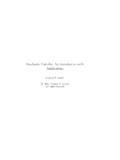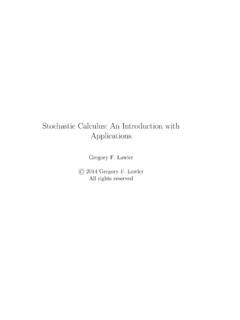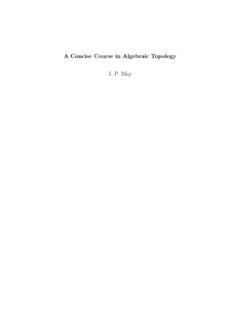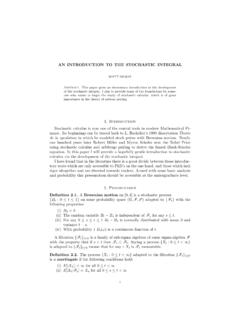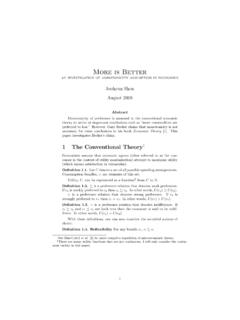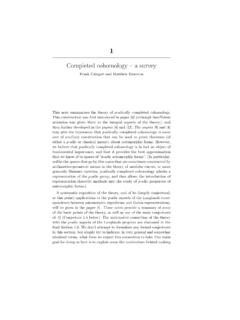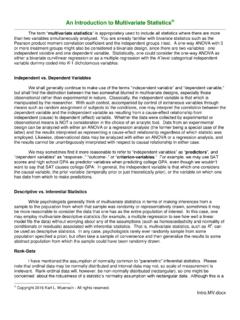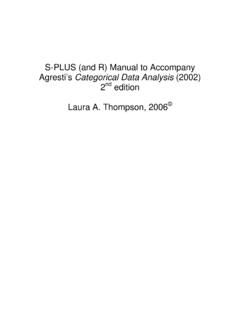Transcription of A CATEGORICAL INTRODUCTION TO SHEAVES
1 A CATEGORICAL INTRODUCTION TO SHEAVESDAPING is a very useful notion when defining and computing many differentcohomology theories over topological spaces. There are several ways to build up sheaftheory with different axioms; however, some of the axioms are a little bit hard to this paper, we are going to present a natural approach from a CATEGORICAL viewpoint,with some remarks of applications of sheaf theory at the end. Some familiarity with basiccategory notions is assumed for the Motivation12. Definitions and Sheaf43. Direct Limit and Sheafification in Sheafification as an Adjoint Functor124. Exact Sequence155. Induced Direct Inverse Adjunction206. A Brief INTRODUCTION to Sheaf Cohomology21 Conclusion and many occasions, we may be interested in algebraic structures defined over local neigh-borhoods.
2 For example, a theory of cohomology of a topological space often concerns withsets of maps from a local neighborhood to some abelian groups, which possesses a naturalZ-module struture. Another example is line bundles (either real or complex): sinceRorCare themselves rings, the set of sections over a local neighborhood forms analyze this local algebraic information, mathematians came up with the notion ofsheaves, which accommodate local and global data in a natural way. However, there aremany fashion of introducing SHEAVES ; Tennison [2] and Bredon [1] have done it in two verydifferent styles in their seperate books, though both of which bear the name Sheaf Theory .In this paper, we would use category theory as a tool (which is closer to Tennison yet some1proofs of this paper may be more CATEGORICAL ) to give an introductory survey to this usefulnotion, and we define SHEAVES , we first want to introduce the notion of presheaves,which is simpler and yet very helpful in understanding sheaf theory.
3 The idea of a presheafover a space is to associate each open set with an algebraic object, which often carries dataabout the open set itself, in such a way that we can establish a map from a bigger open set toa smaller open set inside it. We can think of it as there are layers of open sets where smallerones are sitting above the bigger ones, and we want to assign each layer some algebraicobject in a compactible way from bottom to top. For simplicity, throughout this paper, weare going to useRfor a commutative ring andXfor a topological space unless any spaceX, we want to define a category called the category of open setsOpnX. Theobjects inOpnXare open sets ofXand morphisms are inclusions. Then we define presheafas followingDefinition on a spaceXis a contravariant functorA:OpnopX in each suchR-module are calledsectionsof the presheaf over a particular this definition, for any inclusion mapV U, we get anR-module homomorphismj:A(U) A(V).
4 To distinguish thisR-module homomorphismjfrom others, we namethis particular functorial one therestrictionfromA(U) toA(V), and by convention writej(s) =s|Vfor anys A(U). can define presheaf of many other categories using this definition as particular, since abelian groups areZ-modules, presheaf of abelian groups fits into name restriction maps may not be very meaningful in this context, since in presheavesrestriction maps may not even be surjective. However, as we will see in the case of SHEAVES ,the name restriction is in fact our familiar restriction in the common that there can be more than one possible presheaf on a spaceX, and between twopresheavesAandBthere can be natural transformation such that the following diagramcommutes( )A(U)jA U//B(U)jB A(V) V//B(V)for any open setsV we regard these presheaf functors as objects and natural transformations between themas morphisms, we get a new category called the category of presheaves overX, denoted2byModOpnopXRor simply byPrshfX.
5 By convention, the morphisms (natural transformationbetween presheaves) are called presheaf (1) If we associate every open subset of spaceXto the trivialR-moduleand let the restrictions be the trivial homomorphism, we get thezero presheaf(thetrivial presheaf), denoted by 0. Notice that this is both the initial and terminalobject inPrshfX, and hence the zero object inPrshfX.(2) LetXbe a singleton set{ }. ThenPrshf{ }is the same as the categoryModR.(3) Consider a smooth manifoldM. For each open subsetU, consider the setCM(U) ofall complex-valued smooth maps overU. It is easy to see thatCM(U) is a complexvector space (aC-module). For two open subsetsV U, we can define the restrictionmap to be the restriction of maps inCM(U) to the smaller open subset. This givesus a perfectly good presheaf, which will appear many times in this fact about category of functors is that most constructions can be carried out compo-nentwise in the codomain category.
6 In the case ofPrshfX, since the codomain category isthe algebraic categoryModR, we will expect some basic algebraic notions to be well-definedfor presheaves.(1) Asubpresheafof a presheafAis a presheafBtogether with a presheaf monomorphism :B A. In particular, the zero presheaf is a subpresheaf of any presheaf.(2) Thekernelof a presheaf homomorphism :A Bis categorically defined to be theunique object ker( ) with a presheaf homomorphism intoAthat makes the followingdiagram on the left commute:ker( )//A// 770//BC<< !OOker ( U)i// ! A(U)jA U//B(U)jB ker ( V)i//A(V) V//B(V)To show existence, we just need to take kernels ofR-module homomorphism at everyopen set level, and by the CATEGORICAL property of kernels we get all the restrictionmaps naturally, which fit into the definition of a presheaf (diagram on the right).
7 (3) Theproduct presheafA Bof two presheavesAandBis categorically defined asusual with the diagram below. One can verify that open set level-wise product inthe category ofModRgives the right construction for product presheaf, , settingA B(U) =A(U) B(U) for each open {{ ! ##AA B Aoo B//BIn fact, this definition of sheaf products can be generalized to products among acollection of presheaves of any cardinality.(4) Thecokernelof a presheaf homomorphism is the dual notion of kernel, as in the dia-gram on the left. Construction is also carried out open set level-wise, and restrictions3are natural result of cokernels in the ''0//Aq//!!A/B ! CA(U) U//j B(U)q//j coker(U) ! A(V) V//B(V)q//coker(V)(5) In particular, a quotient presheafB/Ais a cokernel of a monomorphismA B.(6) By a CATEGORICAL convention, we define the image of a homomorphism :A Btobe the kernel of the cokernel of , denoted by img( ) [2].}}
8 (For the readers who knowmore category theory, this definition can be used in any abelian category, to whichPrshfXbelongs.) Notice that a unique homomorphism can be obtained fromAtoimg( ) via the universal property of kernels:A ++ &&//0//Bq++//0//coker( )img( ) = ker(q)88 Readers can easily verify that img( ) is infact a presheaf consisting of (img( ))U= U(A(U)). By convention, this resulting homomorphism fromAto img( ) is alsonamed . the discussion above, we can see that a presheaf may carry a lot of data andwe can always find out data about smaller open sets via restriction maps. However, ideallywe would also want to process information in the opposite direction, namely obtaining dataabout a bigger open set by just looking at its open cover. Thus we would like to imposeone condition to specify this particular kind of presheaf, which are the ones that allow us to glue the pieces over every open set in an open cover, and this is the notion of a presheafAis asheafif it satisfies the following equalizer diagramA(U)f// A(U )g//h// , A(U U )wheneverU= U.
9 The mapfis the product of restrictions, whereasgandhare definedbyg( s ) = , s |U U ,h( s ) = , s |U U One may wonder how this definition helps us glue pieces together. For demonstration,letAbe a sheaf overX. Suppose{U }is an open cover of an open setU. Upon each oftheU , suppose we pick a sections in a compatible way, namely wheneverU intersectU non-trivially, we require thats U U =s U U .Then this definition basically says that there must be a unique sections A(U) such thats|U =s 4for each .An important property of SHEAVES arises from this definition. If we consider the empty setas an open set inXand cover it with the empty covering, then the equalizer diagram abovebecomesA( )f//{0}////{0}where{0}is the terminal object of the categoryModR. (Recall that the 0-fold categoricalproduct gives the terminal object.)
10 Thus for any sheafA,A( ) is always the are alternative definitions for SHEAVES , some involves a topology defined on the sheafa priori; right now we just want to stick with our algebraic definition, and later we will showhow this gives a natural topology on a sheaf. Another common algebraic definition uses twosheaf axioms called monopresheaf and conjunctive [1], which is essentially equivalent tothe equalizer diagram any sheaf is a presheaf, we have morphisms between SHEAVES in the same senseas presheaves, , natural transformations between functors. Notice that any presheafhomomorphism between SHEAVES automatically commutes with the equalizer diagrams asillustrated belowA(U)f// U A(U ) U g//h// , A(U U ) , U U B(U)f// B(U )g//h// , B(U U )Hence we can define a new category called the category of SHEAVES overX, denoted byShfX, to be the full subcategory ofPrshfXwhose objects satisfies Definition Also byconvention, we would call the morphisms in this categorysheaf (1) The zero presheaf obviously satisfies the equalizer diagram and henceis a sheaf as well.

